PRINCETON, NJ -- More Americans have a favorable opinion of President Barack Obama than of any of the four Republican presidential candidates, although Obama also has a relatively high unfavorable rating. Ron Paul, Mitt Romney, and Rick Santorum have about equal favorable ratings, but Santorum and Paul are less well known than Romney. Newt Gingrich's image is the most negative.

These ratings are from a Feb. 16-19 USA Today/Gallup poll and reflect a political landscape in which no more than half of Americans give any of these presidential contenders a positive rating.
Almost all Americans have an opinion about President Obama. On the other hand, despite the high-intensity Republican nomination campaign of the past year, the percentage of Americans who know enough about the four GOP candidates to give an opinion varies widely. Eighty-seven percent are able to rate Gingrich, 86% can rate Romney, 79% Paul, and 73% Santorum.
Santorum, Obama, and Paul are essentially tied when the results are recalculated to take into account only those who give an opinion; roughly half of Americans with an opinion rate each favorably and half unfavorably. Opinions of Romney using this recalculated base skew slightly more negative, while 70% of those with an opinion of Gingrich rate him negatively.
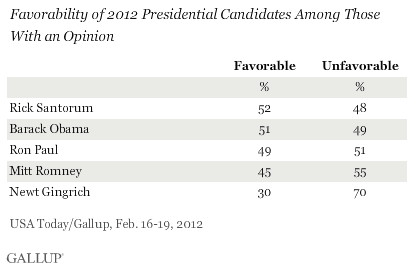
Santorum's Favorable Rating Up
Gallup last measured candidate favorable ratings in this format in December. Since then, Santorum's ratings have changed the most, with a 17-point increase in his favorables and no change in his unfavorables. Opinions of Gingrich, Romney, and Obama have become slightly more negative, with essentially no change in views of Paul.
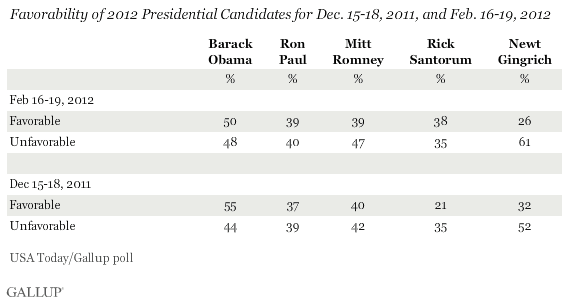
Obama Most Polarizing of the Five Candidates
Obama is the most polarizing of these five politicians, receiving 86% favorable ratings from Democrats and Democratic leaners, and 81% unfavorable ratings from Republicans and leaners. Democrats are, not surprisingly, more negative than positive in their ratings of all four GOP presidential candidates, but are the least negative about Paul, and the most negative about Gingrich. Notably, two-thirds of Democrats have a negative opinion of Romney.
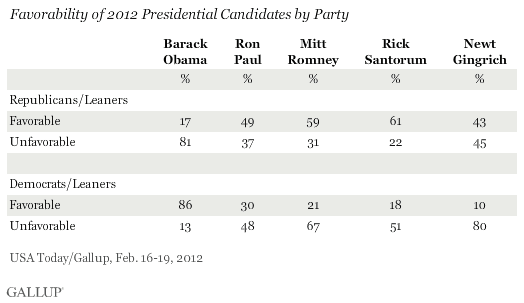
Santorum has the most positive ratings among Republicans, with 61% favorable and 22% unfavorable. Romney has a favorable rating similar to Santorum's among Republicans, but a higher unfavorable rating. Opinions of Gingrich among Republicans are about equally negative and positive.
Obama Favorables Lower Than His Three Predecessors' in February of Re-Election Years
Obama has a less favorable image than any of his three predecessors did in February of their re-election years. George W. Bush (56%), Bill Clinton (60%), and George H.W. Bush (55%) all had at least a 55% favorable rating. Of course, George W. Bush and Clinton went on to win their re-election bids, while the elder Bush's ratings became more negative as 1992 progressed, and he lost to Clinton in November of that year.
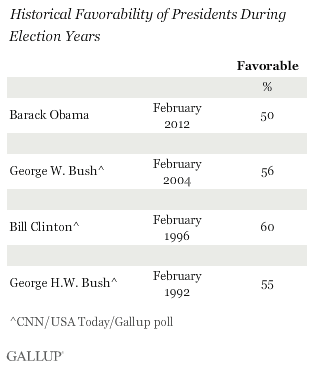
GOP Contenders Less Favorably Positioned Than in Previous Elections
This year's Republican presidential campaign has unfolded in a different fashion than previous years in which non-incumbent Republicans have run for their party's nomination. By February 2008 and February 2000, for example, the eventual GOP nominee was pretty well known. This year, the nominee won't be settled until after February. Perhaps as a result of these different timelines, none of the four Republican presidential contenders currently has an image as positive as those of previous non-incumbent GOP candidates in February of the election year. John McCain's national favorable rating was 56% in February 2008, George W. Bush's was 58% in 2000, and Bob Dole's was 49% in 1996.
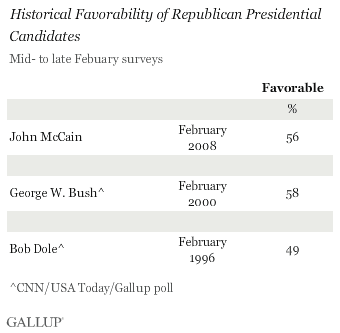
Bottom Line
None of the four Republicans vying for the GOP presidential nomination has strongly favorable images among the American public, and none has favorable images as positive as those of the three previous non-incumbent Republican nominees at the same point in their campaigns. Santorum and Paul have slightly more positive images than either Romney or Gingrich when those with no opinions are factored out, and their images on this basis are on par with President Obama's image.
Santorum also has a higher favorable rating among Republicans who recognize him at this point than any of the other three Republican candidates among those who recognize them -- which befits his current status as the GOP front-runner.
The Republican campaign is now entering a high-frequency stretch of primaries and caucuses, including next week's votes in Michigan and Arizona, and it's likely that as a result, these candidates' images will change once again.
Track every angle of the presidential race on Gallup.com's Election 2012 page.
Survey Methods
Results for this USA Today/Gallup poll are based on telephone interviews conducted Feb. 16-19, 2012, with a random sample of 1,014 national adults, aged 18 and older, living in all 50 U.S. states and the District of Columbia.
For results based on the total sample of national adults, one can say with 95% confidence that the maximum margin of sampling error is ±4 percentage points.
Interviews are conducted with respondents on landline telephones and cellular phones, with interviews conducted in Spanish for respondents who are primarily Spanish-speaking. Each sample includes a minimum quota of 400 cell phone respondents and 600 landline respondents per 1,000 national adults, with additional minimum quotas among landline respondents by region. Landline telephone numbers are chosen at random among listed telephone numbers. Cell phone numbers are selected using random-digit-dial methods. Landline respondents are chosen at random within each household on the basis of which member had the most recent birthday.
Samples are weighted by gender, age, race, Hispanic ethnicity, education, region, adults in the household, and phone status (cell phone only/landline only/both, cell phone mostly, and having an unlisted landline number). Demographic weighting targets are based on the March 2011 Current Population Survey figures for the aged 18 and older non-institutionalized population living in U.S. telephone households. All reported margins of sampling error include the computed design effects for weighting and sample design.
View methodology, full question results, and trend data.
In addition to sampling error, question wording and practical difficulties in conducting surveys can introduce error or bias into the findings of public opinion polls.
For more details on Gallup's polling methodology, visit www.gallup.com.
